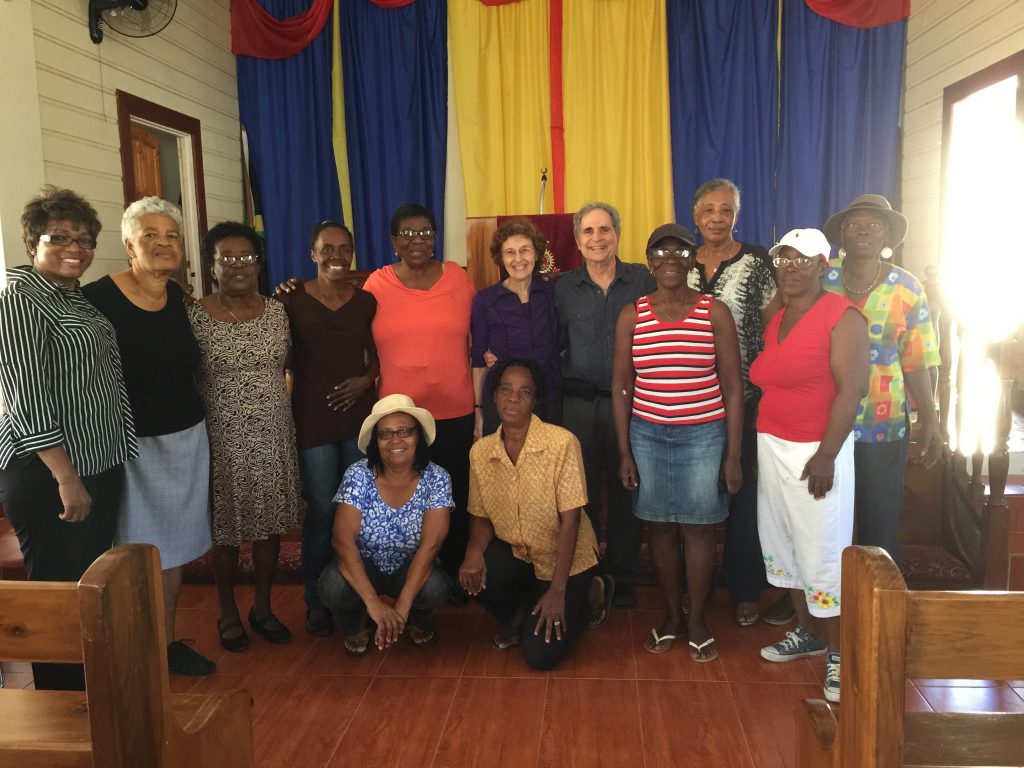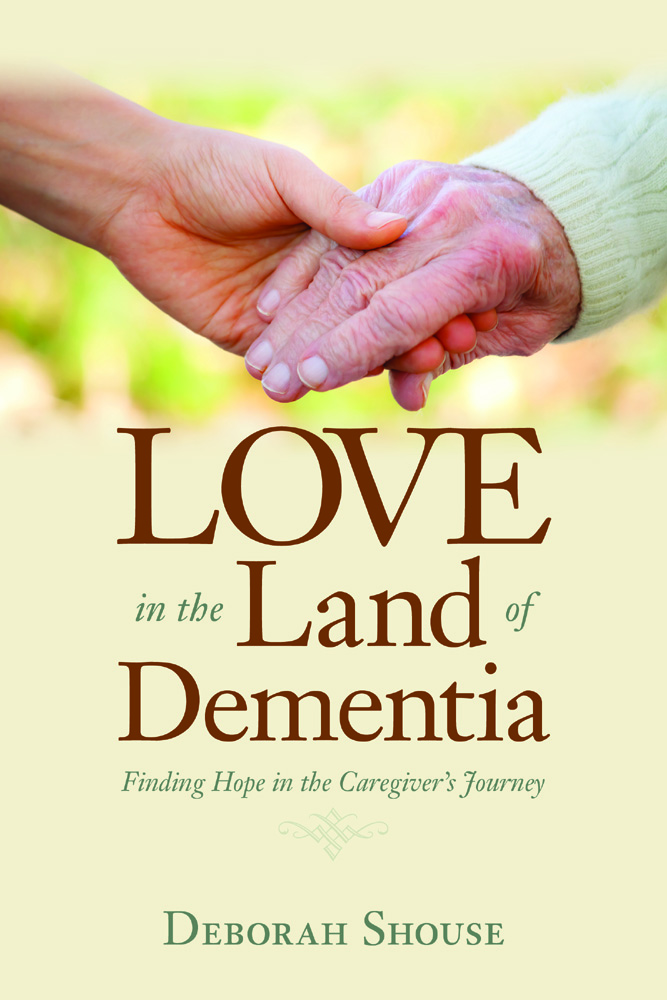Posts Tagged ‘caregiving’
Engaging during the Dementia Journey: One Story and Six Tips
My satchel was packed with potential connectors, not the electrical type, but the emotional, engaging type. I had a sheaf of favorite poems, an Audubon bird book, a list of songs Mom and I liked, some bright red Mardi Gras beads, several colorful scarves, and some paper and markers. I was eager to see what Mom might fancy and I felt prepared for any creative impulse. But as usual, my mom surprised me. When I walked into her room in the memory care community, she was sitting on the bed, fiddling around with a blanket. She smiled and held out her hands. I sat beside her, held her hands, and smiled at her. She laughed. I laughed. She made a little funny face. I mirrored her. I followed her lead until she suddenly gripped my fingers and closed her eyes. I closed mine, but kept sneaking peeks at her. She was asleep, a lazy smile on her face, so I closed my eyes and rested with her. This was one of many ways of engaging during the dementia journey.
Spontaneity and surrender were two of the many lessons my mom taught me during her dementia journey. I loved preparing for our time together, cobbling together ideas to engage us both. Sometimes we sat quietly, leafing through magazines. Other times, I sang Mom show tunes. Still other times, I simply went with the flow and enjoyed Mom’s energy and spontaneity.
My mom has since passed away but her spiritual and emotional gifts linger on. When I visit friends who are living with dementia, here are a few ideas for connecting.
- Choose a quiet space relatively free of distractions.
- Select a time of day when you both have lively energy.
- Bring a project (or projects) you’d both enjoy.
- If the person is shy about creative projects, issue a low-key invitation, such as, “Want to help me with this project?”
- Allow the activity to unfold at its own pace, offering support as necessary and encouragement along the way. Enjoy the process.
- If the activity doesn’t go as planned, don’t worry. Go with the flow and relish your time together.
(A version of this story was originally published in eCareDiary)
Deborah Shouse is the author of Connecting in the Land of Dementia: Creative Activities to Explore Together and Love in the Land of Dementia: Finding Hope in the Caregiver’s Journey.
Art as a Creativity Catalyst: Featuring Grace and Spencer Townley-Lott

How do we keep our sense of connection and creativity through the caregiving journey? That was a question I often asked myself. I wanted to share this story of an extraordinary couple– artist, dementia advocate, and social worker Grace Townley-Lott and her husband, puppeteer, actor, and playwright, Spencer Townley-Lott. Both use art as a creativity catalyst in their work and throughout their lives.
Their elders inspired them. Grace and Spencer were teenagers when her grandmother and his great-grandmotherwere going through a dementia journey. The experience was difficult and impactful.
Grace became a social worker, specializing in older adults and learning how to communicate with people who were living with dementia, often through art.
“It’s incredible how the arts open people up,” Grace says. “Someone who hasn’t painted in 20 years picks up a brush and creates something beautiful. Someone who hasn’t spoken in ages delivers a zinger of a one-liner. Every day, I see how creative people are and the connections that are still possible.”
As Grace unfurled her work experiences, Spencer gained a new understanding of his great-grandmother’s last years. He used those insights to create a critically acclaimed play, Blossom. This play, which utilizes puppets, was funded by a Jim Henson Foundation Grant. It focuses on James Blossom, a retired painter who is living with dementia and his family’s changing relationships.
Caregivers often wonder: “How do we keep creativity alive?” Grace and Spencer were kind enough to share some ideas.
Engaging in New Endeavors: Grace
Try to be in the moment, despite your list of tasks. Respond to and validate emotions. Be willing to go with the flow so you can allow creative sparks.
Pay attention to facial expressions as you invite your loved one to engage. If you start dancing, do their eyes light up and do they laugh? If you offer watercolors and cue your partner to touch the brush to wet paper, does he respond with joy when the color blooms on the page? If you’re having a hard time getting your partner to take a shower, croon a song and waltz with him into the shower. If it doesn’t work, that’s okay, too! But if it does work, it’s a lovely and practical way to connect, create, and take care of physical needs as well.
Sometimes it takes reframing the situation to view the possibilities. An outside person or idea can often expand your thinking.
Creativity Tips for the Care Partner: Spencer
Sometimes, physical actions can help release tension to allow for more creative thinking. Deep breaths and stretching can help you loosen up at first. In the theater world, we start every rehearsal with a physical game or action to help us get focused and leave our stress at the door. Try wiggling and shaking your feet and hands, giving yourself a brief facial massage, stretching as tall as you can, and twisting gently left and right. You’re getting the blood flowing, leaving the worried part of you in the hallway, and getting ready to create.
Allow room for surprises. Try to set the tone by modeling joy and openness. Be willing to try again.
Connecting through Art: Grace
I love viewing art with people who have dementia. Art is so subjective, so there’s no wrong answer to the question, “What do you see?” You can take that first question and lead it along into a fascinating conversation, one question at a time, building a fulfilling conversation with an individual or a group.
In these art viewings, a discussion about a painting can tap into emotions that would otherwise be left undiscussed, or it could lead into a beautiful conversation about the person’s childhood, for example. You never know where the conversation will lead! This creates a failure-free situation where a person with dementia can excel and their answers are valued.
Connecting through Puppets: Spencer
Puppets offer a level of separation for the care partner. For people living with dementia, a puppet’s cues may be simpler to decode, dramatically expressing joy or sorrow. The puppet can place a hand on a shoulder and offer many opportunities for sensory engagement.
Puppets can also encourage intergenerational play, creating connections between family members who may be unsure who to communicate with their loved one with dementia.
Keeping Your Creative Flow: Spencer and Grace
“Creativity is inherent in all of us,” Spencer says. “It’s a muscle you can strengthen. Be patient with yourself. The first day, you can only do one push-up. The second day, you can accomplish two or three. That’s what creativity and artistry feels like. Start small. You are laying the foundation. And it gets easier.”
“Be present and be ready for anything,” Grace says. “By asking your loved ones for advice, truly listening to them, and just being with them, you can form beautiful interactions throughout life.”
To learn more about Spencer, visit
To learn more about Grace, visit
gracetownley.com and theartfuloven.com
Grace is the Director of Truly Inspired Outreach and Education for True Care Home Health.
Deborah Shouse is the author of Connecting in the Land of Dementia: Creative Activities to Explore Together and Love in the Land of Dementia: Finding Hope in the Caregiver’s Journey.
Embracing Person-Centered Dementia Values: The Dementia Action Alliance
One by one, we say hello via video conferencing. We are writers, artists, and arts advocates from all over the country. One sculptor enriches the visual aspects of our meeting by strolling through a museum, giving us occasional glimpses of vibrant art. We meet another artist’s dog. Via video, we see each other’s offices and learn each other’s names and goals. Some of the participants are living with dementia; some are not. All of us are brainstorming ways to use the arts as a catalyst to connect people. Already it is working: through the Dementia Action Alliance, our arts group is already engaging in deep and honest conversation, discussing ways to weave creativity and the arts through June’s conference in Atlanta, and exploring ways we can help others stay connected through the arts.
I have long admired the Dementia Action Alliance and feel honored to be part of their creative process. Their “Person-Centered Dementia Values and Principles” were inspired by the Pioneer Network and have been customized by people living with dementia. Karen Love, Executive Director of DAA, tells us, “Because people who have dementia are the experts, the values are written from their perspective in first person narrative. This orientation helps us focus on what is important.”
Here are some of their core ideas:
Person-Centered Dementia Values and Principles
• I am a person living with dementia. Spend time getting to know me and relating to me as a person with a unique background, life history, interests and capabilities.
• Help me stay connected to what is important to me. Although aspects of my personhood may become increasingly hidden, I am still here.
• A reciprocal relationship is important to me. Autonomy, choices, dignity, privacy, self-determination are fundamental to my well-being.
• Support my holistic emotional, social, physical, cultural, sexual, and spiritual dimensions.
• Promote my personal growth and development. Help me continue to experience purpose, meaning, relationships and enjoyment in my daily life.
• Partner with me, utilize my strengths, and provide the right amount of support and opportunities I need to achieve my goals.
• Some dementia symptoms may interfere with my communication. I communicate the best I can; assume positive intent. Attempt to understand my needs and my reality. Please be compassionate.
For me, reading these principles reminds me how much we are all alike.
For more information on this topic and to learn about the DAA’s upcoming conference:
Conference: Re-Imagine Life with Dementia
You’ll enjoy reading this white paper on Living with Dementia: Changing the Status Quo, DAA
Deborah Shouse is the author of Connecting in the Land of Dementia: Creative Activities to Explore Together and Love in the Land of Dementia: Finding Hope in the Caregiver’s Journey.
Finding Meaningful Memory Care
“I feel like I’ve been on extended vacation,” Ron’s father Frank said, after his first day in a memory care facility. “Today was really enjoyable.” Ron and I just melted with happiness. We had visited many facilities, with the hope of finding meaningful memory care with great activities. Frank couldn’t have said anything nicer.
It’s quite an emotional journey, finding meaningful memory care. I asked my friend, Dr. El, Dr. Eleanor Feldman Barbera, PhD, author of The Savvy Resident’s Guide and a columnist for McKnight’s Long Term Care News, for some tips.
Finding Meaningful Memory Care With Engaging Activities
“Remember, everything is an activity,” says Dr. El. She encourages care partners to seek a community with a dedicated memory care program, so people with cognitive impairments can benefit from all the offered activities.
“In a specialized unit, staff are trained to work with people who are living with dementia,” Dr. El says. “This training can help people enjoy greater independence.”
In one facility, a lady liked to wander into people’s rooms and take their jewelry. Rather than getting upset, the staff understood, framed this as “shopping,” and simply returned the jewelry.
“These kinds of insights create a calmer, slower-paced environment that reduces agitation,” says Dr. El.
Seek Structure, Soothing and Variety
Here are some things to look for, as you visit facilities:
- Is there a home-like atmosphere?
- Is there a structure to the day?
- Are there calming activities scheduled for change of shift? Changing shift is disruptive, so some communities orchestrate a teatime with music or other soothing activities.
You’re also making sure there are a variety of activities throughout the day. These should include:
Outdoor Time: Taking people outside makes a big difference in mood, appetite, and the sense of connection to the world.
Movement: Exercise is an important component to health.
Nurturing: Look for activities that make people feel confident and good about themselves, such as spa days or activities that incorporate skills such as cooking, art or gardening, modified to provide a “success” experience.
Engagement: Being engaged, rather than just entertained, inspires a sense of purpose, creativity, and social connection.
Kindness is Everything
“Meet with the recreational therapist,” Dr. El suggests. “Is she compassionate and caring? Are the staff members kind? You can have all the activities in the world but if they’re not done with gentleness and humanity, they won’t work.”
Let the recreation director know what your loved one likes to do and see if she can adapt the activity.
Stay Involved
Visit as often as you can and attend activities together. Encourage friends and relatives to join you. Meet other residents and get to know the families and staff.
“You can act as a connector to create friendships, so residents engage in their own interaction, even when you aren’t there,” Dr. El says.
For more information, visit Dr. Eleanor Feldman Barbera, PhD, http://www.eldercarewithdrel.com,
Treat yourself to Dr. El’s book, The Savvy Resident’s Guide
Insider’s Tips for Analyzing Activities Programs
My mother had been an artist in her later years, but she stopped painting when she began living with memory loss. Instead, she took comfort in listening to music and in nurturing a baby doll. Ron’s dad studied architecture as a young man, but never had the leisure time to pursue drawing or art. When he moved into a memory care community, he flourished in the Memories in the Making painting program. We worked hard to find care homes that nurtured our parents and my background in healthcare helped us develop a few insider’s tips for analyzing activities programs.
“Families need to share information about favorite hobbies and they also need to be ready for their loved one to try new things and possibly change interests,” says Alisa Tagg, President of the National Association of Activity Professionals. Alisa has helped dozens of facilities build meaningful activity programs.
Here’s an example of how one woman thrived on learning a new skill and giving back:
Mary’s family was amazed when she got involved in a jewelry-making class in the memory care unit. Mary had never thought of making jewelry and she never even wore necklaces, bracelets, or earrings. But she loved beading and was thrilled to share her creative designs with others. Producing something beautiful for others motivated Mary. The facility helped her sell her jewelry and she contributed the money to the activities budget and also donated to charity.
Alisa knows how emotionally challenging it is for families to find good care facilities for their loved ones. Here are some of her insider’s tips for analyzing activities program.
See For Yourself
“You have to view what is going on in the activity room,” she says. “See how the staff interacts with the residents. If there’s an entertainer, is the staff in the back of the room, charting and talking? Or are they in the front, dancing, and singing and engaging with residents and families?”
Look at the activities calendar. Visit the facility at different times and on various days and see if the activities in progress match the scheduled events.
Encourage Engagement
Study the schedule to see how often the residents are engaged, rather than just being entertained. Are they invited to contribute to community service projects? Are they going to sing-alongs or helping with baking projects? People with memory deficits need a variety of activities. Look for a variety of programming that balances the four areas of wellness—spiritual, mental, physical, and emotional.
Visit Programs of Interest
Visit the programs you think your loved one might enjoy.
Find out how many staff members assist in the activities program.
Does the care staff seem aware of the importance of activities? Is there one-on-one assistance for those who want to participate and need extra attention?
Watch for Independent Projects
Is there a place for puzzles, games, cards, and other things people can enjoy independently? Are there opportunities for residents to contribute to their community and to help others around them?
Share Questions and Concerns
“Every facility should have a plan of care meeting, where family can share their expectations and concerns with the nursing staff,” Alisa says. “Ask how your loved one is doing. Share your insights.
A good facility will welcome that meeting.”
Stay Involved
Stay as involved as you can. Helping your loved one connect through meaningful activities may involve trial and error. Get to know the other residents and their families. You’ll stay engaged with your loved one and create a sense of community with a lot of other wonderful people as well. #
To learn more about Alisa Tagg, BA ACC/EDU AC-BC CADDCT CDP and the National Association of Activity Professionals, visit https://naap.info
To delve into creative activities do you can on individual visits, read my latest book, Connecting in the Land of Dementia: Creative Activities to Explore Together.
Build Community Through Sharing Stories.
Just blocks from the bustling tourist shops in the port area of Falmouth Jamaica, stands a white stucco Salvation Army Church. Inside this building, we met with local community leaders. We shared stories and information, offering ways to stay connected throughout the dementia journey. We hoped to build community through sharing stories.
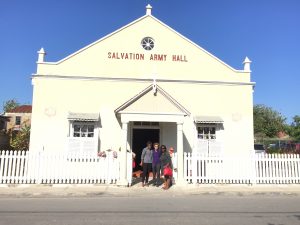
Even before we spoke, Shirley Duncan, a volunteer with Alzheimer’s Jamaica, and one of the event organizers, said, “I have a surprise for you.” She spoke eloquently of the need to talk about dementia, to share experiences, and to be there for the caregivers and people living with dementia. Then she told us that today’s participants were making a commitment to form an on-going group that would educate, advocate, and care for those affected by dementia in their community. “We are calling our group Debron, in honor of you two, because you are the catalysts,” she told us.
Ron had been working with Shirley and Dundeen Ferguson of Alzheimer’s Jamaica for several weeks, setting up the presentation. Shirley and Dahlia Klein orchestrated the details, spreading the word among the community leaders, garnering the venue, and making sure all went smoothly. We were thrilled to be catalysts and delighted to be discussing ideas with such a dedicated group of women, many of whom were former teachers.
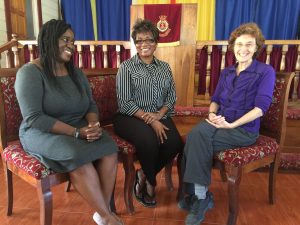 We shared ideas from Dr. Madan Kataria in Mumbai about the power of laughter yoga, and we told a story about creating an inland beach from, Dr. Claire Craig in Sheffield, England. We talked about the power of Dan Cohen’s Music & Memory program and discussed ways to connect through art, citing a story from Teri Miller in Houston, Texas. And we chatted about ways to stay connected through cooking together, sharing our own favorite childhood dishes, which included spiced shrimp, banana porridge, dumplings, roasted corn with shredded coconut, and so much more.
We shared ideas from Dr. Madan Kataria in Mumbai about the power of laughter yoga, and we told a story about creating an inland beach from, Dr. Claire Craig in Sheffield, England. We talked about the power of Dan Cohen’s Music & Memory program and discussed ways to connect through art, citing a story from Teri Miller in Houston, Texas. And we chatted about ways to stay connected through cooking together, sharing our own favorite childhood dishes, which included spiced shrimp, banana porridge, dumplings, roasted corn with shredded coconut, and so much more.
“We will spread these ideas throughout our community,” one of the women told us. “That is what teachers do, we share information.”
We left feeling so inspired and so connected. This is what we all need, caring people, compassionate and eager to learn, ready to offer help and hope.
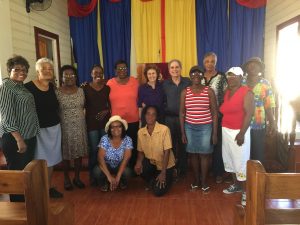
###
During our presentation, we talked about Dr. Madan Kataria’s Ha Ha chorus. At the end, the women said, “We want to sing you a song.” They serenaded us with the Ha Ha chorus. Watch this video and please, sing along.
https://drive.google.com/open?id=0B0elXRV1YrIqUkhqNzN3RkhPSUU
For more about Laughter Yoga, visit Madan Kataria’s website, http://laughteryoga.org

Deborah Shouse is the author of Connecting in the Land of Dementia: Creative Activities to Explore Together and Love in the Land of Dementia: Finding Hope in the Caregiver’s Journey.
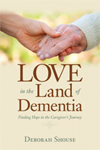

Making a Difference, One Island at a Time
 “We are here to explore meaningful ways to stay connected throughout the dementia journey. We are all going to take what we’ve learned and we need the commitment of all of you to help us reach out to the families living with dementia in our communities,” Raymond Jessurun said when he introduced us at a gathering of healthcare professionals, family caregivers, and government representatives. Raymond, who is Secretary of the St. Maarten Alzheimer’s Foundation, is a passionate and inspiring speaker. He urged everyone to join as volunteers of the Alzheimer’s Foundation to spread the meaningful engagement throughout the island, making a difference, one island at a time.
“We are here to explore meaningful ways to stay connected throughout the dementia journey. We are all going to take what we’ve learned and we need the commitment of all of you to help us reach out to the families living with dementia in our communities,” Raymond Jessurun said when he introduced us at a gathering of healthcare professionals, family caregivers, and government representatives. Raymond, who is Secretary of the St. Maarten Alzheimer’s Foundation, is a passionate and inspiring speaker. He urged everyone to join as volunteers of the Alzheimer’s Foundation to spread the meaningful engagement throughout the island, making a difference, one island at a time.
As a group we discussed many engaging activities, including the joy of singing, the nurturing that animals can offer, the power of looking at art, and the creative conversations that cooking together can inspire. We strategized adding more laughter into the day and the importance of knowing each person’s musical preferences. We were also learned of the challenges family caregivers face, which in residential settings as in the Sint Martin’s Home are being addressed by professional caregivers.
 Our host, Bregje Boetekees, Director of the White and Yellow Cross Care Foundation in St. Maarten, was deeply tuned into the importance of offering an array of individualized activities and to the comfort that nature brings to those who are living with dementia. She is overseeing the construction of a new elderly care facility with a large courtyard that will offer safe and ready outdoor access, as well as fertile ground for gardening and other nature-based activities.
Our host, Bregje Boetekees, Director of the White and Yellow Cross Care Foundation in St. Maarten, was deeply tuned into the importance of offering an array of individualized activities and to the comfort that nature brings to those who are living with dementia. She is overseeing the construction of a new elderly care facility with a large courtyard that will offer safe and ready outdoor access, as well as fertile ground for gardening and other nature-based activities.
As always, we left feeling inspired by each of the people we met. Bregje and her team are constantly exploring ways to enrich the lives of their residents who are living with dementia. Raymond and the board members of the Foundation are an example of how a few compassionate and determined people can make a difference. Just eight years ago, Raymond was struggling to find his mother-in-law the dementia care she needed. His advocacy attracted other caregivers and this year their Foundation, which is recognized by Alzheimer’s Disease International, celebrates its seventh year of serving the community. In June, Raymond is co-coordinating a gathering of leaders of Alzheimer’s organizations of 15 Caribbean countries as a step to forming Alzheimer’s Caribbean. These advocates are making a difference, one caregiver at a time, one facility at a time, one island at a time.
###
We invited everyone to join us in Dr. Madan Kataria’s Ha Ha chorus. Watch this and please, sing and laugh along. Click here to view the St. Maarten HaHa Chorus
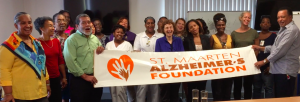
For more about Laughter Yoga, visit Madan Kataria’s website, http://laughteryoga.org
Deborah Shouse is the author of Connecting in the Land of Dementia: Creative Activities to Explore Together and Love in the Land of Dementia: Finding Hope in the Caregiver’s Journey.
Live Well with Dementia: The Pygmalion Effect
“This is one of my favorite songs. What do you think of it, Fran?” We were sitting in Mom’s room in the memory care community, listening to a recording of The Very Thought of You. Even though my mother could no longer answer this question, I liked hearing my father ask it. He honored Mom as his long-time beloved conversational partner. Through this simple action, he was helping her live well with dementia. His example helped me do the same.
 This article by Karen Love, Executive Director of Dementia Action Alliance, reminded me of my dad’s positive outlook. It inspired and touched me and I wanted to share it with you.
This article by Karen Love, Executive Director of Dementia Action Alliance, reminded me of my dad’s positive outlook. It inspired and touched me and I wanted to share it with you.
Live Well with Dementia
By Karen Love, DAA Executive Director
In 1968, Robert Rosenthal and Lenore Jacobson published groundbreaking research that showed teacher expectations of students became self-fulfilling prophecies. At the beginning of a school year, first and second grade students’ IQs were tested. The researchers randomly selected a group of students regardless of their actual test results and led the teachers to believe that this group was capable of great academic achievement. The teachers, perhaps unwittingly, gave the students with the presumed higher IQs more positive reinforcements.
At the end of the year, the students were retested. The group labeled high academic achievers did, in fact, show higher achievement than the other students. Robert Rosenthal summarized this research finding as – “What one person expects of another can come to serve as a self-fulfilling prophecy.” This outcome, retested and proven by many others over the years, has become widely known as the Pygmalion Effect.
The dynamics of the Pygmalion Effect have significant impact for those who want to live well with dementia. There is abundant anecdotal evidence among person-centered dementia care experts that the Pygmalion Effect similarly applies. Family, friends, and others may have low expectations regarding what people living with dementia can and cannot do and how they can function and live. While they may not even be consciously aware of this view, these lowered expectations affect every aspect of the relationship. They don’t engage, interact, and provide opportunities for interesting and fun activities at the same level they would if their expectations were higher.
I experienced the Pygmalion Effect this past week at a memory care assisted living community. I saw a resident sitting alone, apart from the others. I asked a staff member about her and was told she had very advanced dementia.
“What does she like to do?” I asked.
“Nothing, she can’t do anything.”
I knelt beside her and offered a small pillow covered in a soothing, tactile fabric. She immediately started stroking the pillow and then explored the seams. Her expression turned sweet and serene. Touching the fabric was comforting to her. As I was getting ready to leave, the woman’s daughter arrived. I introduced myself and described how much her mother enjoyed the tactile pillow.
“Mom was a seamstress and loves the feel of fabric,” her daughter said, smiling at her mother. “I should bring one of the lap quilts she made when I visit.”
Her daughter was reminded of something her mother liked to do and she felt grateful she could bring something that would please her mom.
I was reminded how important it is to have interesting and engaging items when we visit. Examples include scented lotion, a tactile pillow or fabric scraps, and an enjoyable short story to read aloud.
Helping someone live well with dementia invites us to open our eyes, our hearts, and change our mindset. Instead of perceiving limitations, we can spark the Pygmalion Effect by setting positive expectations. We can help make living fully with dementia a self-fulfilling prophecy.
 Karen Love, gerontologist – Executive Director, Dementia Action Alliance – Powered by People with Purpose
Karen Love, gerontologist – Executive Director, Dementia Action Alliance – Powered by People with Purpose
Deborah Shouse is the author of Connecting in the Land of Dementia: Creative Activities to Explore Together and Love in the Land of Dementia: Finding Hope in the Caregiver’s Journey.


One-minute Tips to Boost Your Happiness
For three weeks, a small pile of books huddled on the floor of my bedroom, next to the bureau. Every time I saw those books, I thought, “I should put them away.” But I walked past them, too busy. Until I read Amy Newmark’s new book, Simply Happy. One of her tips challenged me. “What can you do in one minute?” I took the “One-Minute Tips to Boost Your Happiness” challenge. I swooped into the bedroom, scooped up the tomes, and put them in the bookcase. Then I looked at the blank carpet and smiled. That quick action filled me with joy.
Amy Newmark left her high-powered career as a Wall Street analyst to take over the Chicken Soup series. After years of immersing herself in true stories of miracles, lessons learned, and hopes fulfilled, she wrote her own book, Simply Happy. I was so inspired by Amy’s insights, I asked her to offer a few ideas for busy care partners. Here are some of her “One-Minute Tips to Boost Your Happiness.”
Amy’s Insights for Care Partners
Counting Blessings Adds Up to Happiness
“The gateway to happiness is counting your blessings,” Amy says. “If you’re not grateful for what is in your life, how can you be happy?”
Scientific studies have proven that people who are actively grateful are happier, healthier, and more productive. Plus, they get along better with family members, colleagues, and others.
“You can easily learn gratitude,” Amy says.
To start, each day jot down three things for which you’re grateful. Strive for three different ideas each day. At the end of the month, you’ll have documented nearly a hundred blessings.
“Writing and speaking your gratefulness changes your perception,” Amy says. “You start looking for good things during the day. You can share your blessings with your partner and encourage him to consider his own.”
Some people drop the blessings into a box, and then read them at the end of the day or the end of the month.
Smiling Serves You
Smile even when you don’t feel like it. Often, when you smile, people smile back. This boosts everyone’s spirits and energy. If they don’t give you a grin, it doesn’t hurt you.
“Your smile will change the way people react to you,” Amy says.
Zipping from Zero to 60 Brings Joy
Set a timer for 60 seconds and zip through a task you’ve been putting off. File the insurance policy that sprawls across the dining room table. Unload the dishwasher. Take your vitamins.
“Doing even one of those tasks every day will lighten your spirits,” Amy says.
Dropping Perfection and Embracing Your Own Abilities
Abandon your pursuit of perfection and strive for your own version of excellence.
“When you try to be perfect, you can’t get a lot done,” Amy says. “For most of us, it’s better to do five things at 90 percent than one thing at 100 percent.”
I love Amy’s final piece of wisdom:
“Treat yourself nicely,” she says. “Use the fragrant soap you save for guests. Indulge in a rich bit of good chocolate or a fresh crisp apple. Put the good sheets you save for company on your own bed.
Give yourself a tiny pleasure every day.”
For more happiness boosts, read Simply Happy.
Visit Amy’s website at www.amynewmark.com or www.chickensoup.com
Extra tip from Deborah: If you like to write, consider submitting one of your own life stories to a Chicken Soup book. I’ve shared my stories in dozens of their books and it’s such a meaningful experience. Go to www.chickensoup.com, scroll down to the bottom, and click on “Submit Your Story” to learn how.
Deborah Shouse is the author of Connecting in the Land of Dementia: Creative Activities to Explore Together and Love in the Land of Dementia: Finding Hope in the Caregiver’s Journey.

Enjoy Dementia Inclusive Holiday Cooking
“Who prepared this delicious meal?” a friend asked during a holiday dinner.
I named my brother Dan, our head chef, first. Then I included the support team—myself, my mom, my daughters and nephews.
“Did I help?” Mom whispered as I passed her the mashed potatoes.
“You sure did,” I told her. ”You mashed the potatoes, put the marshmallows on the sweet potato casserole, and mixed the fruit salad.”
“That’s good,” she said. “I like to help.”
Our desire to help and contribute to seasonal celebrations doesn’t end with a diagnosis of dementia. It’s lovely to linger in the kitchen together, preparing food for the holidays. It’s even lovelier when you can adapt and enjoy dementia inclusive holiday cooking so that people of varying abilities can participate.
Rebecca Katz, author of The Healthy Mind Cookbook, sees food as a great equalizer, something anyone can enjoy regardless of abilities. Fixing a delicacy for someone offers a tangible and delicious way to give back.
Here are some tips so you can enjoy dementia inclusive holiday cooking.
- Leaf through a favorite family cookbook or recipe box and use the pictures and recipes as a catalyst for conversation. Ask open-ended questions, such as, ”What does that brownie recipe make you think of?” “What do you like about the holiday season?”
- Select a special recipe to make together. Choose simple, safe and satisfying tasks, such as measuring, adding ingredients , stirring, and tasting.
- Chose a time of day when you’re both rested.
- Create a comfortable kitchen environment, by playing familiar seasonal songs you can both hum or sing along to. Reduce extraneous noise and distractions, such as a television in the background.
- If you wish, take photos during the experience. That way, you can relive the adventure and share with family and friends.
- Indulge in instant gratification, if possible, by sampling your work when the cooking is complete.
- Even if the person living with dementia can’t help prepare food, he can still enjoy sitting in on the action and the conversation.
Whether you’re stirring a pot of orzo or dropping mint leaves into cool water, enjoy your time of creation and connection in the kitchen.
A longer version of this piece originally appeared on Joan Lunden’s excellent website: Enjoy Dementia Inclusive Holiday Cooking. Thanks to Sue Fitzsimmons, MS, ARNP, Judith Fertig, author of The Memory of Lemon, Kate Pierce, LMSW, Alzheimer’s Association Greater Michigan Chapter, and Rebecca Katz, author of The Healthy Mind Cookbook
Deborah Shouse is the author of Connecting in the Land of Dementia: Creative Activities to Explore Together and Love in the Land of Dementia: Finding Hope in the Caregiver’s Journey.


